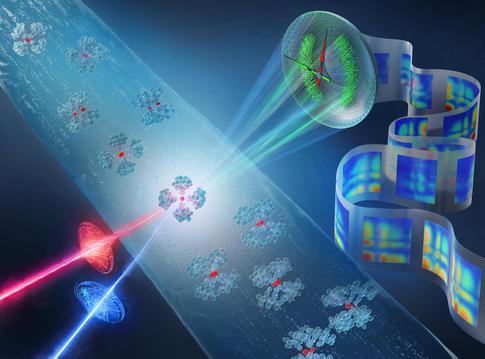XFEL: New approach to data analysis of X-ray experiments
New approach to data analysis of X-ray experiments

Optical pulses are applied to excite a solution of [Ir2(dimen)4]2+ molecules, and ultrashort X-ray laser pulses are used to track the evolution of the system over time. Correlations in the scattered intensities reveal details of ultrafast electron and structural dynamics in the photoexcited solution. Copyright: EuXFEL, Tobias Wüstefeld
Understanding rapid chemical reactions at the electronic, atomic and molecular level is crucial for controlling reaction rates and obtaining the desired products. An international group of scientists including European XFEL scientist Ruslan Kurta and key partners from European XFEL, Technical University of Denmark, SLAC National Accelerator Laboratory and DESY used ultrashort XFEL pulses to track the dynamics of photoinduced reactions in molecular solutions on the femtosecond timescales (a femtosecond is a quadrillionth of a second). The experiment was carried out at the X-ray Correlation Spectroscopy (XCS) instrument of the SLAC’s X-ray laser Linac Coherent Light Source (LCLS) in Menlo Park, California.
The team combined measurements with advanced simulations to explore the fundamental processes in chemical reactions. Traditional scattering approaches, such as time-resolved X-ray solution scattering (TRXSS), are based on the direct analysis of the scattered intensity. While this simplifies the interpretation of the experimental results, it provides only limited structural information. In their newly published paper in the Journal Physical Chemistry Chemical Physics the researchers pursued an alternative route for analysis of the TRXSS measurements. This approach is based on the application of so called angular cross-correlation functions, which were originally proposed to facilitate biological structure determination.
They tested the new approach on a photoexcited solution of the model photocatalyst [Ir2(dimen)4]2+. It enabled them to observe the ultrafast changes in the atomic structure of the catalyst molecules, as well as electronic transitions which are relevant for catalytic reactions.
“We expect our work to be of interest to researchers investigating ultrafast dynamics of photoreactions in liquid or gas phases”, says Ruslan Kurta. “Our approach can contribute to interdisciplinary research areas such as catalysis, photosynthesis, nanoscience and bioimaging.”
Contact:
Dr. Ruslan Kurta
Email: ruslan.kurta@xfel.eu
